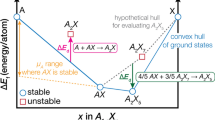Abstract
Diffusion of the 4d transition elements in Ni has been investigated within the five-frequency model framework using migration energy barriers calculated from the first principles. Agreement with counterintuitive experimental/calculated data is observed; atoms in the middle of 4d row have the smallest atomic radii while exhibiting the lowest diffusivity as compared to larger atoms at the beginning and the end of 4d row. We show that 4d solute diffusion is controlled mainly by the size misfit. The larger atoms have higher solute–vacancy binding energies and lower migration barriers. Both were shown to correlate with a displacement of the equilibrium solute position toward the adjacent vacancy. The difference in mechanisms controlling sp- and transition elements diffusion rates in Ni is discussed.







Similar content being viewed by others
References
Donachie MJ, Donachie SJ (2002) Superalloys: a technical guide, 2nd edn. ASM International, Materials Park
Davis JR (2000) ASM specialty handbook: nickel, cobalt, and their alloys. ASM International, Materials Park
Le Claire AD (1978) Solute diffusion in dilute alloys. J Nucl Mater 69–70:70–96
Manning JR (1968) Diffusion kinetics for atoms in crystals. Van Nostrand, London
Howard RE, Manning JR (1967) Kinetics of solute-enhanced diffusion in dilute face-centered-cubic alloys. Phys Rev 154:561
Janotti A, Krčmar M, Fu CL, Reed RC (2004) Solute diffusion in metals: larger atoms can move faster. Phys Rev Lett 92:085901
Krčmar M, Fu CL, Janotti A, Reed RC (2005) Diffusion rates of 3d transition metal solutes in nickel by first-principles calculation. Acta Mater 53:2369
Qiong W, Shu-Suo L, Yue M, Sheng-Kai G (2012) First principles calculations of alloying element diffusion coefficients in Ni using the five-frequency model. Chin Phys B 21:109102
Zacherl CL (2012) A computational investigation of the effect of alloying elements on the thermodynamic and diffusion properties of fcc Ni alloys, with application to the creep rate of dilute Ni–X alloys. PhD thesis, Penn State University
Mantina M, Wang Y, Chen LQ, Liu ZK, Wolverton C (2009) First principles impurity diffusion coefficients. Acta Mater 57:4102
Sandberg N, Holmestad R (2006) First-principles calculations of impurity diffusion activation energies in Al. Phys Rev B 73:014108
Simonovic D, Sluiter MHF (2009) Impurity diffusion activation energies in Al from first principles. Phys Rev B 79:054304
Glicksman ME (1999) Diffusion in solids: field theory, solid state principles and applications. Wiley, New York
Mehrer H (1990) Landolt–Bornstein—New Series III/26: atomic defects and diffusion. Diffusion in solid metals and alloys. Springer, Berlin
Neumann G, Hirschwald W (1974) The correlation factor of impurity diffusion in F.C.C metals. Zeitschrift für Physikalische Chemie 89:309–319
Ledbetter HM, Reed RP (1973) Elastic properties of metals and alloys, I. Iron, nickel, and iron–nickel alloys. J Phys Chem Ref Data 2:531
Kresse G, Furthmuller J (1996) Efficient iterative schemes for ab initio total-energy calculations using a plane-wave basis set. Phys Rev B 54:11169
Kresse G, Hafner J (1994) Norm-conserving and ultrasoft pseudopotentials for first-row and transition elements. J Phys 6:8245
Kresse G, Joubert J (1999) From ultrasoft pseudopotentials to the projector augmented-wave method. Phys Rev B 59:1758
Blöchl PE (1994) Projector augmented-wave method. Phys Rev B 50:17953
Perdew JP, Chevary JA, Vosko SH, Jackson KA, Pederson MR, Singh DJ, Fiolhais C (1992) Atoms, molecules, solids, and surfaces: Applications of the generalized gradient approximation for exchange and correlation. Phys Rev B 46:6671 and (1993) Erratum. Phys Rev B 48:4978
Vosko SH, Wilk L, Nusair M (1980) Accurate spin-dependent electron liquid correlation energies for local spin density calculations: a critical analysis. Can J Phys 58:1200
Monkhorst HJ, Pack JD (1976) Special points for Brillouin-zone integrations. Phys Rev B 13:5188
Adams JB, Foiles SM, Wolfer WG (1989) Self-diffusion and impurity diffusion of FCC metals using the 5-frequency model and the Embedded Atom Method. J Mater Res 4:102
http://webelements.com/. Accessed 20 December 2013
Allison HW, Samelson H (1959) Diffusion of aluminum, magnesium, silicon, and zirconium in nickel. J Appl Phys 30(9):1419–1424
Novikov DL, Cetel A, Maloney M, Schlichting K, Cowles B, Okatov S, Lomayev I, Gornostyrev Yu, Burlatsky S (2011) Electronic origin of fast sulfur diffusion in 3d transition metals. Bull Amer Phys Soc 01:56
Lomaev IL, Novikov DL, Okatov SV, Gornostyrev YuN et al (2014) On mechanism of sulfur fast diffusion in 3d transition metals. Acta Mater 67:95–101
Acknowledgements
The work of Lomaev I.L. was partially supported by a RFBR Project No. 13-03-00641 and Ural Branch of RAS Project No 12-U-2-1004.
Author information
Authors and Affiliations
Corresponding author
Rights and permissions
About this article
Cite this article
Lomaev, I.L., Novikov, D.L., Okatov, S.V. et al. First-principles study of 4d solute diffusion in nickel. J Mater Sci 49, 4038–4044 (2014). https://doi.org/10.1007/s10853-014-8119-1
Received:
Accepted:
Published:
Issue Date:
DOI: https://doi.org/10.1007/s10853-014-8119-1




